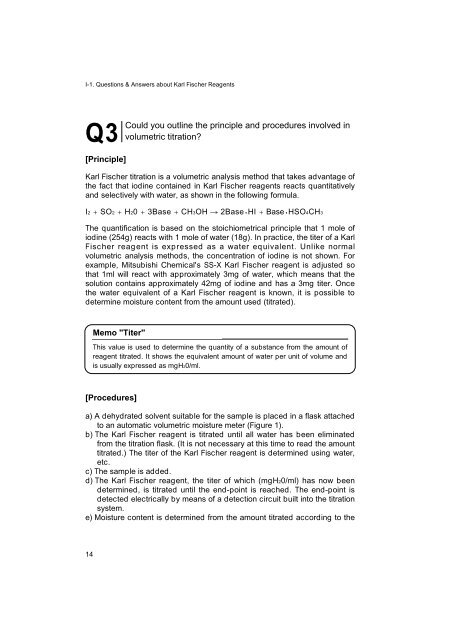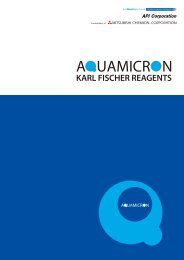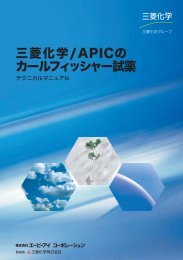Development of Karl Fischer Reagents
Development of Karl Fischer Reagents
Development of Karl Fischer Reagents
You also want an ePaper? Increase the reach of your titles
YUMPU automatically turns print PDFs into web optimized ePapers that Google loves.
I-1. Questions & Answers about <strong>Karl</strong> <strong>Fischer</strong> <strong>Reagents</strong><br />
Q3<br />
[Principle]<br />
14<br />
Memo "Titer"<br />
This value is used to determine the quantity <strong>of</strong> a substance from the amount <strong>of</strong><br />
reagent titrated. It shows the equivalent amount <strong>of</strong> water per unit <strong>of</strong> volume and<br />
is usually expressed as mgH20/ml.<br />
[Procedures]<br />
Could you outline the principle and procedures involved in<br />
volumetric titration?<br />
<strong>Karl</strong> <strong>Fischer</strong> titration is a volumetric analysis method that takes advantage <strong>of</strong><br />
the fact that iodine contained in <strong>Karl</strong> <strong>Fischer</strong> reagents reacts quantitatively<br />
and selectively with water, as shown in the following formula.<br />
I2 � SO2 � H20 � 3Base � CH3OH � 2Base � HI � Base � HSO4CH3<br />
The quantification is based on the stoichiometrical principle that 1 mole <strong>of</strong><br />
iodine (254g) reacts with 1 mole <strong>of</strong> water (18g). In practice, the titer <strong>of</strong> a <strong>Karl</strong><br />
<strong>Fischer</strong> reagent is expressed as a water equivalent. Unlike normal<br />
volumetric analysis methods, the concentration <strong>of</strong> iodine is not shown. For<br />
example, Mitsubishi Chemical's SS-X <strong>Karl</strong> <strong>Fischer</strong> reagent is adjusted so<br />
that 1ml will react with approximately 3mg <strong>of</strong> water, which means that the<br />
solution contains approximately 42mg <strong>of</strong> iodine and has a 3mg titer. Once<br />
the water equivalent <strong>of</strong> a <strong>Karl</strong> <strong>Fischer</strong> reagent is known, it is possible to<br />
determine moisture content from the amount used (titrated).<br />
a) A dehydrated solvent suitable for the sample is placed in a flask attached<br />
to an automatic volumetric moisture meter (Figure 1).<br />
b) The <strong>Karl</strong> <strong>Fischer</strong> reagent is titrated until all water has been eliminated<br />
from the titration flask. (It is not necessary at this time to read the amount<br />
titrated.) The titer <strong>of</strong> the <strong>Karl</strong> <strong>Fischer</strong> reagent is determined using water,<br />
etc.<br />
c) The sample is added.<br />
d) The <strong>Karl</strong> <strong>Fischer</strong> reagent, the titer <strong>of</strong> which (mgH20/ml) has now been<br />
determined, is titrated until the end-point is reached. The end-point is<br />
detected electrically by means <strong>of</strong> a detection circuit built into the titration<br />
system.<br />
e) Moisture content is determined from the amount titrated according to the




